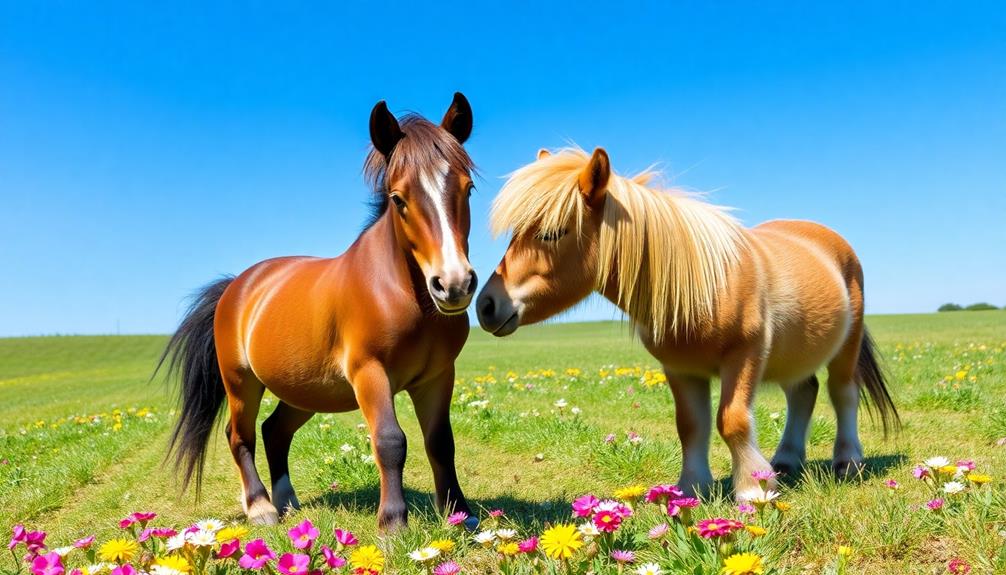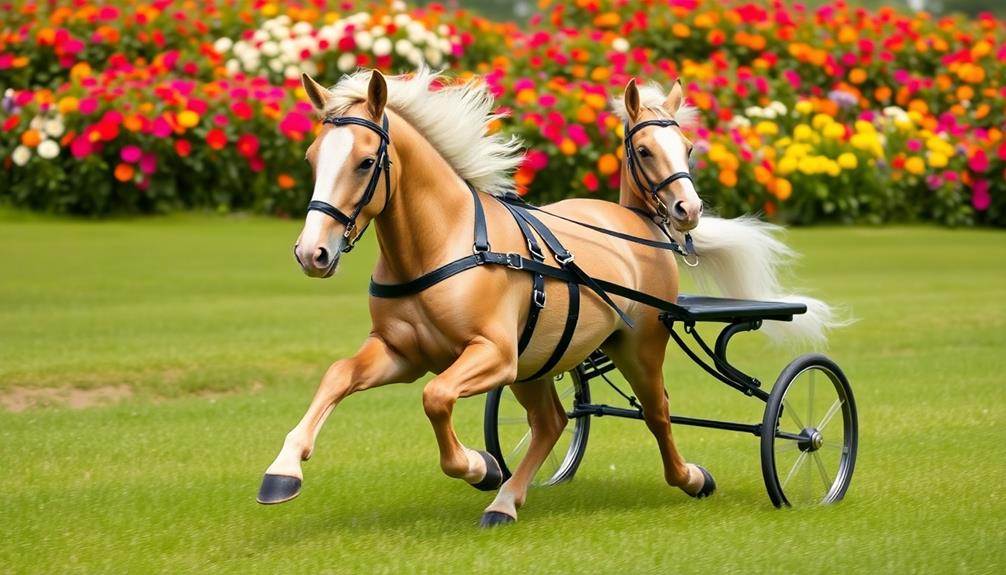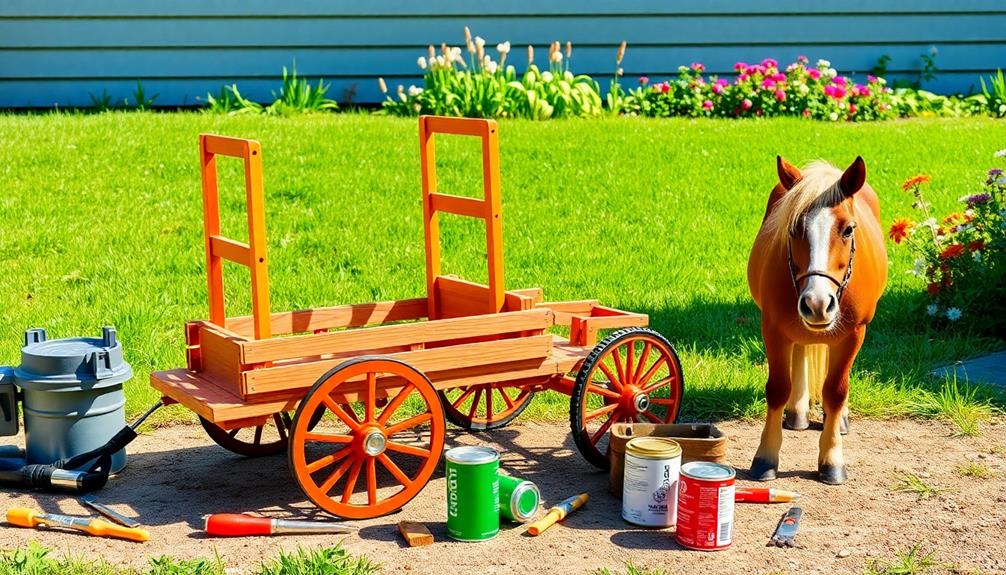When deciding between a miniature horse and a miniature pony, consider your lifestyle and needs. Miniature horses typically stand up to 38 inches tall, resembling full-sized horses with refined features, making them great companions or service animals. In contrast, ponies are stockier and more suited for riding, ideal for children and equestrian activities. Miniature horses may require more specialized care to avoid obesity, while ponies thrive on a higher-calorie diet based on their activity. Assess your preferences and daily routine to choose the right fit. Explore further to uncover more details about their unique traits and care requirements.
Key Takeaways
- Miniature horses stand up to 38 inches tall and are bred for elegance, while ponies are stockier and generally under 14.2 hands tall.
- Consider your intended use: miniature horses excel in therapy and driving, while ponies are better suited for riding and child-friendly activities.
- Assess dietary needs: miniature horses require careful calorie management to prevent obesity, while ponies can thrive on higher-calorie diets based on activity.
- Evaluate conformation and build: miniature horses resemble larger horses, while ponies have thicker coats and shorter legs, affecting appearance and utility.
- Both provide companionship, but determine which aligns with your lifestyle, as miniature horses are gentle and ponies are reliable for young riders.
Definition and Classification
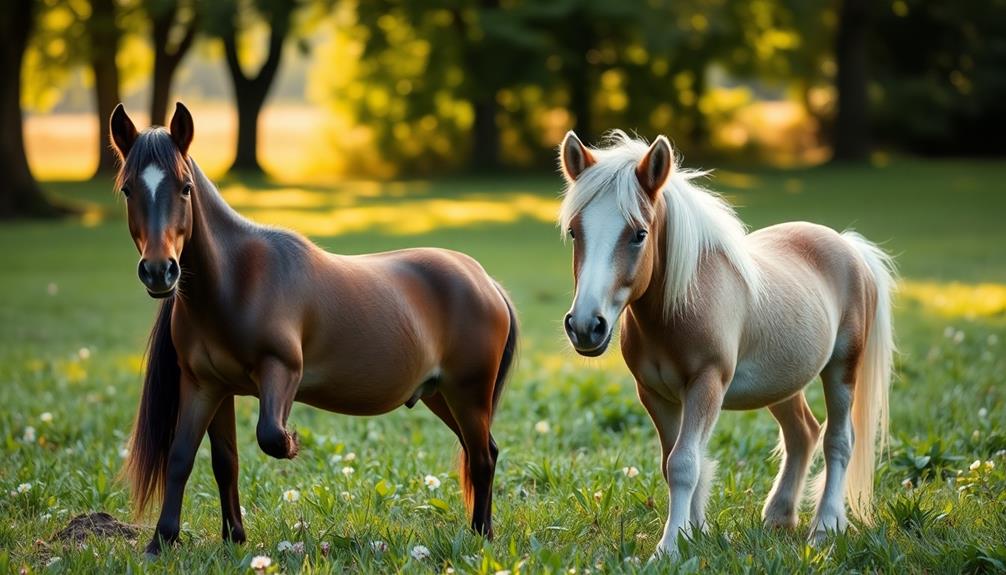
When it comes to understanding the difference between miniature horses and miniature ponies, it's vital to grasp their definitions and classifications. Miniature horses are defined as small horses that measure no more than 38 inches (9.5 hands) tall. The American Miniature Horse Association (AMHA) sets specific standards for these horses, requiring them to resemble full-sized horses in proportions.
In contrast, ponies are equines measuring less than 14.2 hands (58 inches) tall, which can lead to confusion between the two. Understanding proper care and nutrition is important for both types, as they've unique needs that can affect their health and behavior, similar to how hamster care and costs require attention to diet and environment.
When you think about miniature horses vs. ponies and minis, remember that the primary distinction lies in their build and breeding purpose. Miniature horses are bred for elegance and refined features, while pony breeds, like Shetland and Welsh, are stockier with different conformation.
Misclassification often occurs in marketing, with terms like "mini horse" and "pony" being used interchangeably. This misunderstanding can cloud your judgment when choosing between these small horses, so it's important to recognize their distinct characteristics and classifications. Understanding these differences will help you make informed decisions about which equine companion fits your needs.
Size and Appearance

When you compare miniature horses and miniature ponies, size is a key factor.
Miniature horses stand up to 38 inches tall, while ponies are generally under 14.2 hands.
You'll also notice distinct differences in their builds and visual characteristics, which highlight their unique breeds.
Understanding the symptoms of BPD can help in recognizing emotional responses that may parallel the way these animals exhibit their traits.
Height Measurement Differences
Understanding the height measurement differences between Miniature Horses and Miniature Ponies is vital for anyone interested in these charming equines. Miniature Horses are defined as a maximum height of 38 inches, or 9.5 hands, while ponies are categorized as equines measuring less than 14.2 hands, which is 58 inches. This fundamental distinction is important when selecting your ideal companion, especially when considering health needs and potential cold medications overview for your pet.
Height measurement differences can vary greatly based on breed. For instance, some pony breeds, like the Welsh Pony, have no upper height limit as long as they exceed 13.2 hands.
In contrast, Miniature Horses typically resemble larger horses in body structure, while ponies are stockier, with thicker builds and shorter legs.
When evaluating size, consider that Miniature Horses often compare in height to large dogs, whereas ponies are generally larger and more suitable for riding activities.
Accurate height classifications are essential; a pony standing at 12 hands may be a valid equine, while a Miniature Horse under 38 inches mightn't be acknowledged in that way by some enthusiasts.
Understanding these height differences will help you make an informed decision about which equine is right for you.
Build and Conformation
The differences in build and conformation between Miniature Horses and Miniature Ponies are striking and play a significant role in their overall appearance and suitability for various activities.
Miniature horses are bred for elegance and refined features, resembling full-sized horses. They stand a maximum height of 38 inches, with the American Miniature Horse Association (AMHA) defining the ideal height at under 34 inches. This focus on refinement gives them a more streamlined look.
In contrast, ponies are generally stockier, with thicker coats, manes, and tails. They typically measure less than 14.2 hands (58 inches) tall and exhibit a more robust build. Different pony breeds, such as Shetland ponies, Hackneys, and Exmoors, have unique conformation traits that distinguish them from miniature horses.
When choosing between the two, consider their build and conformation. Miniature horses might be more suited for activities requiring agility and grace, while ponies may excel in strength and versatility.
Ultimately, understanding these differences will help you select the right companion for your needs.
Visual Characteristics Comparison
Comparing the visual characteristics of Miniature Horses and Miniature Ponies reveals distinct differences in size and appearance that can help you make an informed choice.
Miniature Horses typically stand under 38 inches tall, with the American Miniature Horse Association (AMHA) recognizing those under 34 inches. In contrast, ponies, like the Shetland pony, are measured in hands and can reach heights up to 14.2 hands (58 inches), meaning some ponies might be taller than miniature horses.
When you look at their builds, you'll notice that ponies tend to be stockier, featuring thicker coats, manes, and tails, along with shorter legs and wider barrels.
Miniature Horses, however, have a more refined look, resembling larger horses in their proportions. This elegant appearance contributes to their charm, making them popular for various activities, including shows and companionship.
Misclassification can occur, particularly in marketing, leading to confusion between the terms "mini horse" and "pony." Some small horses may be inaccurately labeled as ponies, despite being classified as miniature horses, so it's important to take into account these visual traits when making your decision.
Historical Background
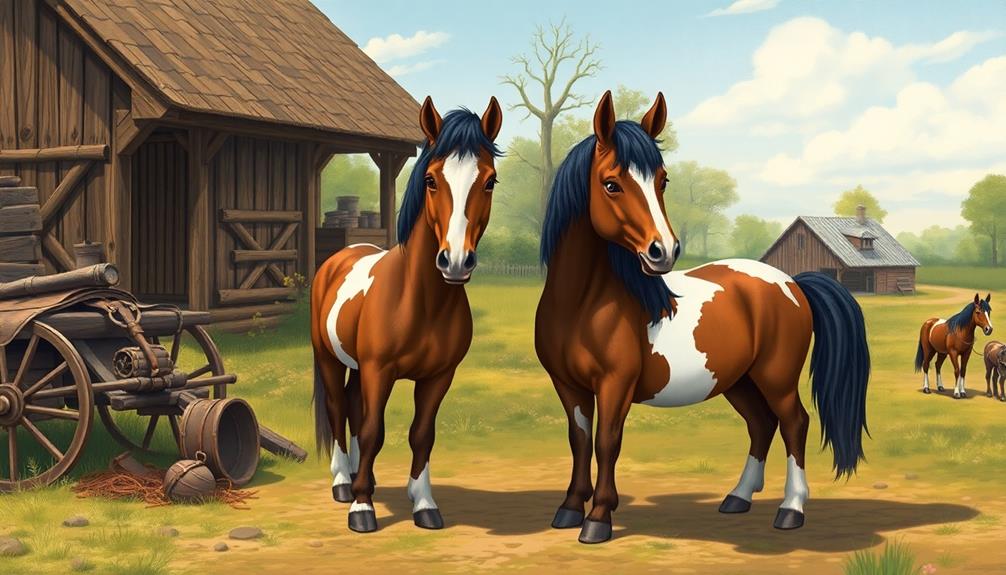
Since their origins in the mid-17th century, Miniature Horses have carved out a unique niche in equine history. First appearing at the Palace of Versailles, these horses were bred for their small size and strength, making them ideal for work in coal mines.
The American Miniature Horse emerged through careful breeding, combining small horses and Shetland ponies to develop distinct characteristics while maintaining a genetic link.
In the United States, ponies have been domesticated since the 1800s, primarily serving agricultural purposes. Meanwhile, wild ponies roamed Assateague Island as early as the 1600s.
As the 19th century progressed, the popularity of Miniature Horses grew, shifting from essential working animals to cherished companions known for their gentle temperament.
The establishment of organizations like the American Miniature Horse Registry helped solidify their status, promoting and maintaining breed standards.
Today, Miniature Horses are recognized not just for their unique history but also for their role as beloved domestic animals, making them excellent choices for families and enthusiasts alike.
Understanding this background can help you appreciate the distinct qualities that set Miniature Horses apart from ponies.
Uses and Roles
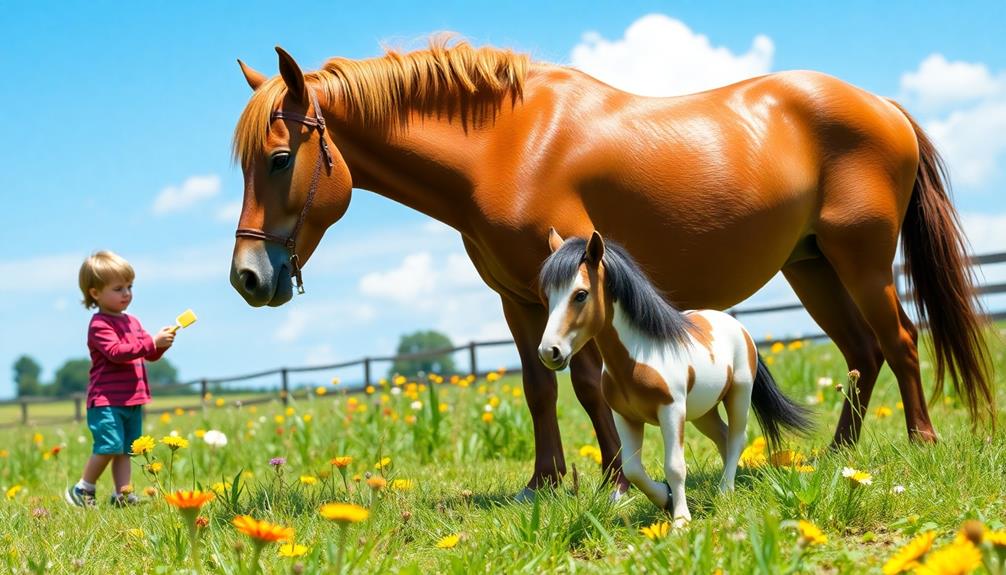
Understanding the historical significance of Miniature Horses and ponies sets the stage for exploring their various uses and roles today.
Miniature Horses are increasingly recognized as service animals, offering invaluable assistance to individuals with disabilities. They can guide the blind or provide emotional support, showcasing their versatility and gentle nature.
On the other hand, ponies shine as children's mounts, making them the perfect choice for young riders participating in equestrian sports. Their strength and reliability also make them ideal for farm work, demonstrating their hardworking spirit.
Miniature Horses excel in driving and in-hand classes, where their refined features and elegance truly stand out in competitive settings.
Families appreciate ponies for riding lessons and competitions, as they provide a safe and enjoyable experience for children.
Both Miniature Horses and ponies serve as companions, but Miniature Horses are particularly favored for therapy work. Their gentle disposition makes them excellent therapy animals, providing comfort and joy to those in need.
Whether you're looking for a service animal, a competitive mount, or a loving pet, understanding these roles can help you choose the right fit for your lifestyle.
Health and Care Considerations

When caring for miniature horses and ponies, you'll need to pay close attention to their dietary needs and restrictions, as their size influences their health.
Regular veterinary care is a must for both, ensuring they stay healthy and avoid common issues.
Don't forget that exercise and socialization play key roles in their well-being, so make time for interactive activities and companionship.
Dietary Needs and Restrictions
In caring for miniature horses and ponies, addressing their dietary needs is vital for maintaining their health and well-being. Miniature horses often require careful dietary management to prevent obesity, as they're more prone to weight-related health issues like laminitis and metabolic syndrome. To meet their nutritional needs, you should provide a lower-calorie feed specifically designed for maintenance.
Ponies, on the other hand, are generally stockier and hardier, needing fewer calories for maintenance. Their dietary needs can be more flexible, allowing them to thrive on higher-calorie diets based on their activity levels.
Regardless of the type, it's important to monitor body condition scores regularly to prevent obesity-related complications.
Both miniature horses and ponies benefit from a balanced diet that includes quality forage and appropriate supplements when necessary. Be cautious about treats; sugary options can contribute to weight gain.
Additionally, make certain they've access to fresh water at all times. By understanding and catering to their unique dietary needs, you'll promote a healthier lifestyle for your miniature horse or pony, making sure they thrive in your care.
Veterinary Care Essentials
Regular veterinary care is essential for keeping your miniature horse or pony healthy and thriving. Both require routine vaccinations, deworming, and dental exams to guarantee optimal equine health.
Miniature horses often face specific health challenges due to their size, so it's imperative for you to monitor their diet closely. This helps prevent obesity-related issues like equine metabolic syndrome (EMS) and laminitis.
Ponies, while stockier and hardier, also need regular weight management checks. They generally require fewer calories, but keeping an eye on their weight is fundamental to avoid health complications.
Hoof care is another crucial aspect of veterinary care for both miniature horses and ponies. Be aware that some farriers may hesitate to work on minis due to their size, so it's significant to find professionals experienced with these breeds.
Understanding the unique health risks associated with each type is key to effective preventative care strategies.
Exercise and Socialization Requirements
How do exercise and socialization impact the well-being of your miniature horse or pony? Both require regular exercise and socialization to thrive. Miniature horses enjoy interactive activities that engage their playful nature, while ponies are generally more adaptable and can participate in a wider range of physical activities, including riding and equestrian sports.
Here's a quick comparison to help you understand their exercise and socialization needs:
| Aspect | Miniature Horses | Miniature Ponies |
|---|---|---|
| Exercise Requirements | Regular structured activities | Versatile routines; adaptable |
| Socialization Needs | More structured interaction needed | Naturally social in herds |
| Companionship Importance | Critical for mental well-being | Also needs companionship |
| Health Considerations | Careful weight management essential | Robust but still needs regular care |
In the Miniature Horse vs. Miniature Pony debate, remember that both benefit from companionship. Miniature horses may require more structured social interaction, while small ponies thrive in herds. Prioritizing exercise and socialization will guarantee a happy, healthy life for your equine friend!
Behavioral Traits

Many owners find that miniature horses and miniature ponies exhibit distinct behavioral traits that can influence their suitability as companions or riding partners.
Miniature horses are generally known for their agreeable and friendly personalities, often seeking your companionship. Their playful and curious nature thrives on interaction, making them engaging partners.
On the other hand, ponies may show more independence and stubbornness, which can lead to mischievous behavior. If you're inexperienced, a pony might outsmart you, resulting in behavioral issues if not handled properly.
While the temperament of each individual can vary widely, some ponies can be sociable and adaptable in herd settings. However, others might display defensiveness around larger horses.
It's vital to understand these differences when choosing between these two. Consistent and positive training methods work well for both miniature horses and ponies, but ponies often require firmer handling to prevent problematic behaviors.
Consequently, recognizing their unique behavioral traits is essential for making the right choice based on your lifestyle and experience level.
Ownership and Lifestyle Factors
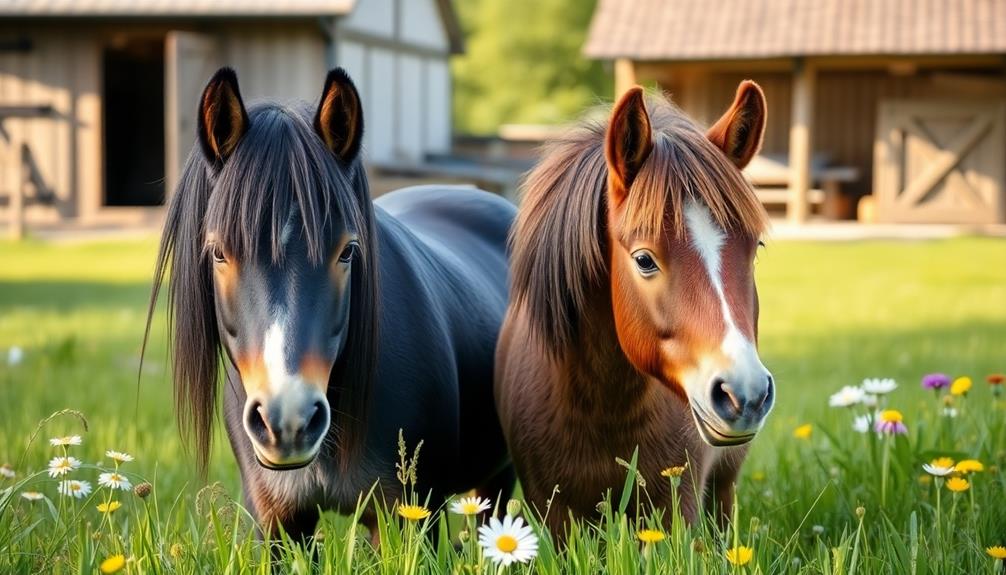
When considering ownership of a miniature horse or pony, it's crucial to evaluate your lifestyle and living situation. Mini horses and ponies can fit well into family life, but each requires different care and attention.
If you're looking for a non-riding companion, a miniature horse, which typically stands under 38 inches tall, is ideal. They're often bred for companionship and service roles. On the other hand, if you're interested in riding or equestrian activities, a small pony under 14.2 hands may be a better fit, accommodating children and small adults.
Both types need daily care, including feeding, grooming, and regular veterinary check-ups. However, ponies generally present a lower maintenance cost due to their hardier evolution, while miniature horses need careful dietary management to prevent obesity.
Additionally, consider compatibility with other horse breeds; small to medium ponies can coexist safely with full-sized horses, but you may need extra precautions with miniature horses to prevent injuries.
Joining organizations like the Miniature Horse Association (AMHA) or Pony Club can also enhance your ownership experience, providing resources and community support.
Frequently Asked Questions
Do I Have a Mini Horse or a Pony?
To determine whether you have a mini horse or a pony, measure its height. If it's under 38 inches, it's likely a miniature horse.
Check its features too; miniature horses have refined, horse-like traits, while ponies are stockier with thicker coats.
If you're still unsure, consider consulting breed standards or an expert. This'll help clarify any confusion and guarantee you know exactly what you have in your care.
Is It Easier to Ride a Horse or a Pony?
When it comes to riding, you'll likely find ponies easier to handle than horses. Their stockier build and lower height make them more suitable for beginners, especially children.
Ponies can comfortably carry lighter weights, and their generally versatile nature allows for various riding disciplines.
Horses, being taller and often more powerful, require more experience to ride safely.
Is a Miniature Pony a Good Pet?
Absolutely, a miniature pony can be a fantastic pet! Their gentle nature and smaller size make them perfect for families and kids.
You'll find they require similar care as larger ponies, but they're generally easier to manage. Plus, their sociable demeanor means they thrive on companionship, both from humans and other animals.
If you're looking for a loving, low-maintenance pet that can bond with you, a miniature pony might be just right!
What Are the Disadvantages of Miniature Horses?
Imagine a tiny ship adrift in a vast ocean; that's what owning a miniature horse can feel like.
They face unique health challenges, such as obesity and laminitis, if not monitored closely. Their dietary needs require diligence, and finding a vet who specializes in their care can be tough.
Plus, their small size limits riding opportunities, and without proper socialization, they can develop behavioral issues that complicate your companionship.
Conclusion
In choosing between a miniature horse and a miniature pony, consider your lifestyle and needs. Did you know that miniature horses can be trained for various tasks, including therapy work, thanks to their gentle disposition? Both options have unique traits and care requirements, so reflect on what fits best with your lifestyle. Whether you want a playful companion or a hardworking partner, there's a perfect miniature equine waiting for you!
